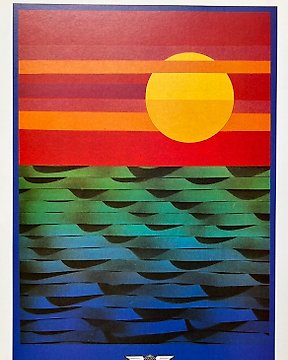
So-Ky - Balaton (Lake) IBUSZ poster - Bauhaus style
No. 82606401

No. 82606401

Official offset print on thick paper of the original one
Iconic poster about the Lake Balaton region
Shipping is with insurance
An artist couple who have been working together since the beginning of the 1950’s, they were highly effective and convinced propagandists for the socialist system. In addition to political posters, they worked in every field of visual communication.
Their posters represent the typical visual culture of the 1960’s, illustrating a style known today as “retro” or socialist modernism that defined the furniture, architecture, and graphic design of the period. After the decline of mandatory socialist realism, a new trend became influential. It combined typical socialist subjects (the life of workers, factories, family, agriculture) with a modern attitude and style: they have used a style close to constructivism. This tendency, now called soc-modern, became significant in the eastern bloc in the 1960s. So-Ky used several techniques, like paper cut, drawing, photo, photomontage and they often have used only clear typographic design. For their political posters they use simple but effective forms and symbols, sometimes without any text. For example, the red sickle and hammer and ripped barbed wire stand together for the “liberation” of 1945.
Long deacription:
Éva Kemény graduated in textile design from the College of Applied Arts in 1949, where her mentors were Pál Miháltz and Béla Molnár. She met her husband, László Sós, a fellow artist who started his career in István Irsai's workshop, in the early forties. They first presented a joint artwork at the 1956 national poster exhibition, already using the artistic name SO-KY. This work caught the attention of the United Bulb Company (Egyesült Izzó), leading to a lasting collaboration with the artist duo. Among their numerous works designed for the company, the most notable is the creation of the visual identity still used by Tungsram. They also worked for many other major companies, designing product and cultural posters for CASCO, IBUSZ, and BNV, but their most significant activity became the design of political posters.
Sós and Kemény never concealed their political beliefs, as art historian Nóra Aradi puts it, "embracing ideological and material responsibility and risk." In the fifties, they were not yet involved in political poster design. They received their first commission in this direction in 1967 when the avant-garde style they represented had already integrated well into the cultural policy of the Kádár era. The artist duo's committed left-wing stance and their pacifism stemming from their experiences during the war, coupled with a strong anti-American sentiment in the sixties, became a defining factor in the domestic graphic arts scene. This was mainly due to their numerous traveling exhibitions with an educational purpose.
Since official commissions were relatively rare and mostly limited to holidays, anniversaries, congresses, and party events, SO-KY often created political posters with their own content and messages. In addition to the customary posters celebrating anniversaries such as April 4th, May 1st, August 20th, November 7th, International Women's Day, Mother's Day, and Children's Day, they were instrumental in spreading the genre of peace posters in Hungary. Their highly imaginative and impactful propaganda arsenal included strong visual contrasts (contrasting symbols of the developed Western world with starving African children), meaningful visual elements (the CIA snake coiled around the tree of independent countries, or the peace dove dressed in the American flag and shot through the heart), as well as effective typography (forming the letters "NATO" into a cross).
SO-KY achieved significant results not only in poster design but also in the field of logo design. Their emblems, bearing elements of pop and op-art, generally served as occasional printed decorations, but some were particularly successful and entered commercial circulation. In addition to the aforementioned Tungsram visual identity, they created logos for Budapest FÜSZÉRT Company, Képcsarnok, Csepel School Gallery, Művészeti Alap, Luxus Department Store, and Hotel Karancs in Salgótarján. One of their most beautiful works was the 1975 KGST emblem, where an effective and elegant decoration was formed by a swirling black pattern within three arcs, centered around an unusually small five-pointed star.
SO-KY's work was also crucial in exhibition design, an area of advertising graphics that is less explored and researched. They were entrusted with prestigious projects such as the "60 Years of the Soviet Union" exhibition, which was produced in fifty copies and presented in 14 countries, the "25 Years of the Workers' Guard," or the major Bartók exhibition presented in three Tunisian cities in 1970. They also designed the permanent exhibition of the Hungarian Labor Movement Museum, which opened in 1979 in the former Royal Palace in Buda.
How to buy on Catawiki
1. Discover something special
2. Place the top bid
3. Make a secure payment